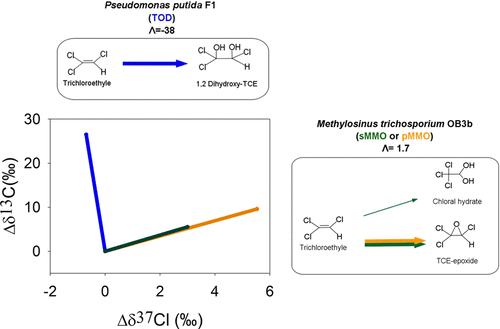δ13C and δ37Cl Isotope Fractionation To Characterize Aerobic vs Anaerobic Degradation of Trichloroethylene
Almog Gafni, Christina Lihl, Faina Gelman, Martin Elsner, Anat Bernstein
文献索引:10.1021/acs.estlett.8b00100
全文:HTML全文
摘要

Trichloroethylene (TCE) is a carcinogenic organic chemical impacting water resources worldwide. Its breakdown by reductive vs oxidative degradation involves different types of chemical bonds. Hence, if distinct isotope effects are reflected in dual element (carbon and chlorine) isotope values, such trends could help distinguishing both processes in the environment. This work explored dual element isotope trends associated with TCE oxidation by two pure bacterial cultures: Pseudomonas putida F1 and Methylosinus trichosporium OB3b, where the latter expresses either soluble methane-monooxygenase (sMMO) or particulate methane-monooxygenase (pMMO). Carbon and chlorine isotope enrichment factors of TCE (ε13C = −11.5, −2.4, and −4.2‰; ε37Cl = 0.3, −1.3, and −2.4‰, respectively) differed strongly between the strains. The dual element isotope trend for strain F1 (ε13C/ε37Cl = −38) reflected, as expected, primary carbon and negligible chlorine isotope effects, whereas unexpectedly large chlorine isotope effects became apparent in the trend obtained with strain OB3b (ε13C/ε37Cl = +1.7 for sMMO and pMMO). Therefore, although dual element isotope analysis partly reflects predicted differences in oxidative vs reductive (ε13C/ε37Cl = 3.4–5.7) degradation, the unexpected OB3b fractionation data may challenge field interpretation.
|
Modeling Secondary Organic Aerosol Production from Photosens...
2018-04-06 [10.1021/acs.estlett.8b00101] |
|
Reductive Defluorination of Branched Per- and Polyfluoroalky...
2018-04-06 [10.1021/acs.estlett.8b00122] |
|
Kaolin Alleviates Graphene Oxide Toxicity
2018-04-06 [10.1021/acs.estlett.8b00135] |
|
Estimating the Transfer Range of Plasmids Encoding Antimicro...
2018-04-05 [10.1021/acs.estlett.8b00105] |
|
Identification of Chain Scission Products Released to Water ...
2018-04-04 [10.1021/acs.estlett.8b00119] |